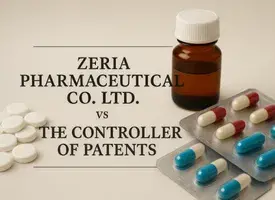By Swaraj Singh Raghuwanshi and Nishu Aditya
Introduction:
In the recent case of Zeria Pharmaceutical Co. Ltd vs The Controller of Patents, an appeal was filed by the Zeria Pharmaceutical Co. Ltd, before the Delhi High Court against the refusal order by the Assistant Controller of Patents & Designs (“Learned Controller” hereafter). The Zeria Pharmaceutical Co. Ltd (“Appellant” hereafter) filed an Indian Patent Application no. 3630/DLNP/2011 (“Subject Application” hereafter) as a divisional application from the Parent Indian Patent Application No. 1090/DELNP/2007, claiming novel intermediate compound formula (5a) on the ground of grounds of lack of inventive step (Section 2(1)(ja)) and non-patentability under Section 3(d).
This case specifically addresses the interpretation and application of Section 3(d) of the Patents Act, 1970, that the slight modification of structure of known pharmaceutical intermediates compound must exhibits enhance therapeutic efficacy to be patentable under Section 3(d) of the Indian Patent Office.
A brief overview of the matter:
The Zeria Pharmaceutical Co is a Japanese Corporation. The appellant had filed a divisional application Patent Application No. 3630/DELNP/2011 titled “A COMPOUND REPRESENTED BY FORMULA (5a)” on May 13, 2011 from the parent Indian Patent Application No. 1090/DELNP/2007. The appellant filed the request for examination on August 04, 2011 and the application was published by the Patent Office on April, 06, 2012. The First Examination Report (“FER” hereafter) was issued on February 24, 2015. The following substantive objections were raised by the Learned Controller via the said FER:
- Lack of inventive step under Section 2(1)(ja)of the Act;
- Non patentable under Section 3(d)of the Act.
The appellant submitted a detailed response against the objection raised in the FER vide letter dated July 23, 2015. Thereafter, a hearing was scheduled on August 12, 2016, and post hearing, written submissions were filed by the appellant on August 26, 2016. The subject patent application was refused in 2016 on the ground of lack of inventive step under Section 2(1)(ja) and non-patentability under Section 3(d) of the Act.
| Stage | Date |
| Filing of Indian Patent Application No 3630/DELNP/2011 | 13/05/2011 |
| Filing of Parent Indian Patent Application No. 1090/DELNP/2007 | February 09, 2007 |
| Request for Examination | August 04, 2011 |
| Date of publication u/s 11A | April 06, 2012 |
| FER issue date | February 24, 2015. |
| Date of Hearing | August 12, 2016 |
| Written examination submission date | August 26, 2016 |
Appeal filed by the Appellant
The Appellant in this case raised the following points while challenging the Learned Controller’s reasoning:
- Regarding the objection of inventive step, the appellant argued that the Learned Controller erroneously relied on the cited prior art D1, which was deemed irrelevant to the inventive step according to the International Search report ( Category A, i.e., Documents defining the general state of the art)
- The Appellant asserted that the Controller overlooked the affidavit submitted in support of the inventive step under Section 2(1)(ja) and made an error in concluding that there was no enhanced efficacy under Section 3(d), despite the provision of experimental data to substantiate this claim.
- Furthermore, D1 “teaches away” from the claimed invention. They argued that the specific methyl ester with a methoxycarbonyl group, as claimed, is neither produced nor specifically described in the prior art document D2, and deriving it from D2’s generic disclosure is not obvious. They also contended that the Controller’s order employed impermissible hindsight analysis, lacking motivation for a Person Skilled in the Art (PSITA) to arrive at the invention.
Contentions of the Respondent:
The Respondent asserted that the patent application has been rightly denied under Section 2(1)(ja) and 3(d) of the Patents Act, as the claimed compounds are an evident derivative of those disclosed in documents D1 and D2. The Respondent noted that the sole distinction between Example 6 of D2 and the claimed compound in the subject application is the substitution of “ethoxycarbonyl” for “methoxycarbonyl”. Moreover, D1 and D2 originate from the same applicant and both present similar intermediates within the same technical domain. Consequently, it seems to be an endeavor by the Appellant to merely extend protection for known process intermediates, which is not allowed.
The Respondent further contended that the claimed compound lacks the enhanced efficacy mandated by Section 3(d), and the data submitted pertains to a hydrochloride salt of a compound of formula (7) rather than the compound of formula (7) itself, while the subject application primarily concerns a process for the preparation of the compound of formula (7) or 7(a), and not the hydrochloride form of formula (7) or 7(a). Therefore, the data provided is irrelevant to the claimed invention of the base compound. As a result, the invention is deemed non-patentable under Section 3(d) as it is a derivative of a known compound without any inventiveness or enhanced therapeutic efficacy.
Judgment passed by the High Court:
Objection 1 – Patentability under Section 3(d):
The Court determined that the compound claimed in the subject application is a derivative of the compounds presented in Example 6 of D2, as both share the same core structure, differing only slightly in the ester group, specifically the ethoxycarbonyl group in D2 compared to the methoxycarbonyl group in the claimed compound. Moreover, according to Section 3(d) of the Act, such minor modifications among derivatives necessitate proof of enhanced therapeutic efficacy.
However, the Appellant did not succeed in demonstrating such enhanced therapeutic efficacy for the claimed compound. The comparative data submitted by the Appellant did not address the enhancement of the “therapeutic efficacy” of the claimed compounds; thus, it cannot be considered an invention under Section 3(d) of the Act. This perspective is consistent with the Supreme Court’s ruling in Novartis AG v. Union of India, which stated that efficacy refers to “the ability to produce a desired or intended result.” Additionally, in the context of a medicine that purports to cure a disease, the efficacy test can only be defined as “therapeutic efficacy.” As the Appellant acknowledged that the claimed compound is an intermediate, it is not feasible to ascertain the “therapeutic efficacy” of the claimed compound. Consequently, the Appellant did not demonstrate the therapeutic efficacy of the claimed compounds in comparison to the prior art documents D1 and D2, thereby validating the rejection under Section 3(d)
Objection 2 –Lack of inventive step under Section 2(1)(ja)
The Court upheld the Learned Controller’s decision to reject the subject application, determining that the replacement of “ethoxy” with “methoxy” constituted an evident modification for an individual skilled in the art, considering the prior art documents D1 and D2. Both documents reveal structurally analogous compounds. Importantly, Example 6 of D2 specifies “ethoxy” as the “D” group, while formula (II) incorporates “methoxy” as a representative lower alkoxy group. This clearly indicates that “methoxy” was explicitly mentioned as a lower alkoxy substituent for “D” in the compounds of formula (II), thereby affirming its existence in the prior art. The Court concurred with the Controller’s rationale, referencing Agriboard International LLC v. Deputy Controller of Patents and Designs3, which delineates the factors pertinent to assessing the inventive step. The Court observed that the Controller had meticulously examined both the subject invention and the prior art, also identifying Example 6 of D2 as the nearest prior art. Consequently, the objection under Section 2(1)(ja) concerning the lack of inventive step was deemed well-founded.
Moreover, the Court maintained that the Controller correctly noted that document D1 presented an intermediate compound of formula III, utilized in the synthesis of 2-hydroxybenzoylaminothiazole derivatives. In light of the disclosures in D1 and D2, the Court asserted that a person skilled in the art would find it routine to derive the claimed compound based on these teachings. The Appellant’s assertion that D1 “teaches away” from the invention was dismissed. The Court clarified that the lack of a direct teaching does not imply a “teaching away,” as established in Astrazeneca AB & Anr. v. Torrent Pharmaceuticals Ltd.4
The Court determined that the existing prior art, especially compound 38 from D2, would encourage a Person Skilled in the Art (PSITA) to explore structural alterations and to consider the compounds of the claimed invention. Given that both the prior art and the claimed invention are situated within the same technical domain, the claimed compounds were found to lack an inventive step as per Section 2(1)(ja) of the Act. Consequently, the appeal is hereby dismissed.[1]
Conclusion:
The judgment reinforces several key principles that will shape future of pharmaceutical patent prosecutions in India. First, the Court’s emphasis on clearly identifying the ‘known substance’ when raising Section 3(d) objections ensures that applicants receive adequate notice and opportunity to respond meaningfully to such rejections. This procedural safeguard prevents arbitrary application of Section 3(d) and promotes transparency in patent examination.
Second, the decision clarifies that therapeutic efficacy cannot be established for pharmaceutical intermediates, as these compounds do not directly treat diseases. This interpretation aligns with the Supreme Court’s guidance in Novartis AG v. Union of India and provides clear direction for applicants seeking patent protection for intermediate compounds in pharmaceutical synthesis pathways.
Third, the Court’s analysis of inventive step demonstrates the importance of thorough prior art analysis and the application of the person skilled in the art standard. The rejection of the “teaches away” argument and the finding that minor structural modifications (such as substituting ethoxy with methoxy groups) constitute obvious variations reinforces the high bar for establishing inventive step in pharmaceutical chemistry.
This decision likely to influence patent prosecution strategies for pharmaceutical companies operating in India. Applicants must ensure robust evidence of enhanced therapeutic efficacy when claiming derivatives of known compounds, while patent examiners must provide clear, reasoned explanations for Section 3(d) objections. The judgment strikes an appropriate balance between preventing evergreening of pharmaceutical patents and ensuring fair examination procedures, ultimately serving both innovation incentives and public health interests in the Indian pharmaceutical landscape.


